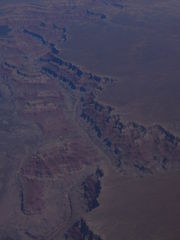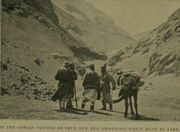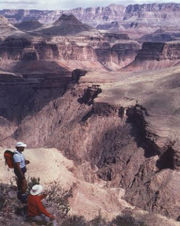Canyon

A canyon (occasionally spelled cañon) or gorge is a deep ravine between cliffs often carved from the landscape by a river. Most canyons were formed by a process of long-time erosion from a plateau level. The cliffs form because harder rock strata that are resistant to erosion and weathering remain exposed on the valley walls. Canyons are much more common in arid areas than in wetted areas because weathering has a greater effect in arid zones. Canyon walls are often formed of resistant sandstones or granite. Submarine canyons form underwater, generally at the mouths of rivers. The word canyon is Spanish in origin (cañón). The word canyon is generally used in the United States, while the word gorge is more common in Europe and Oceania, though it is also used in some parts of the United States and Canada. The military derived word defile is occasionally used in the United Kingdom.
A famous example is the Grand Canyon in Arizona with an average depth of one mile and a volume of 4.17 trillion cubic meters,[1] in the southwestern United States, canyons are important archeologically because of the many cliff-dwellings built there, largely by the earlier inhabitants, Ancient Pueblo Peoples.
The Yarlung Zangbo Grand Canyon (or Tsangpo Canyon), along the Yarlung Tsangpo River in Tibet, China, is regarded by some as the deepest canyon in the world, and is slightly longer than Grand Canyon making it one of the world's largest.[2]
Sometimes large rivers run through canyons as the result of gradual geological uplift. These are called entrenched rivers, because they are unable to easily alter their course. The Colorado River and the Snake River in the northwestern United States are two examples of tectonic uplift.
Canyons often form in areas of limestone rock. Limestone is to a certain extent soluble, so cave systems form in the rock. When these collapse a canyon is left, for example in the Mendip Hills in Somerset and Yorkshire Dales in Yorkshire, England.
A canyon may also refer to a rift between two mountain peaks such as those in ranges such as the Rocky Mountains, the Alps, the Himalayas or the Andes. Usually a river or stream and erosion carve out such splits between mountains. Examples of mountain type canyons are Provo Canyon in Utah or Yosemite National Park in California's Sierra Nevada. Canyons within mountains or gorges that only have an opening on one side are called box canyons. Slot canyons are very narrow canyons, often with smooth walls.
Contents |
Largest canyons

- Tsangpo Canyon in Tibet, China
- Grand Canyon in Arizona, United States
- Copper Canyon in Chihuahua, Mexico
The definition of "largest canyon" is rather imprecise, as a canyon can be large by its depth, length, or the total area of the canyon system. Also the inaccessibility of the major canyons in the Himalaya contributes to their not being regarded as candidates for the biggest canyon. The definition of "deepest canyon" is similarly imprecise, especially if one includes mountain canyons as well as canyons cut through relatively flat plateaus (which have a somewhat well-defined rim elevation).
Lists
List of canyons


- Black Canyon of the Gunnison, Colorado, USA
- Blyde River Canyon, Mpumalanga, South Africa
- Canyon Sainte-Anne, Quebec, Canada
- Charyn Canyon, Kazakhstan
- Chicamocha Canyon, Santander, Colombia
- Colca Canyon, Arequipa, Peru
- Cotahuasi Canyon, Arequipa, Peru
- Fish River Canyon, Namibia, Africa
- Fraser Canyon, British Columbia, Canada
- Grand Canyon of Torotoro, Torotoro, Potosi Department, Bolivia
- Grand Canyon of the Yellowstone, Wyoming, USA
- Guartelá Canyon, Paraná, Brazil
- Hells Canyon, Idaho and Oregon, USA
- Horseshoe Canyon, Alberta, Canada
- Huasteca Canyon, Monterrey, Mexico
- Kanionet e Skraparit, in Albania
- Kings Canyon (Northern Territory), Australia
- Little River Canyon, Alabama, USA
- Matka Canyon, Republic of Macedonia
- Nfeye Canyon, Portugal
- Nine Mile Canyon, Utah, USA
- Ouimet Canyon, Ontario, Canada
- Palo Duro Canyon, Texas, USA
- Rugova Canyon, Kosovo, Europe
- Saturban canyon, Santander, Colombia
- Shnizow Canyon, Uşak, Turkey
- Sumidero Canyon, Chiapas, Mexico
- Tara River Canyon, Montenegro, Europe
- Valla Canyon, Kure,Turkey
- Waimea Canyon, Hawaii, USA
- Yarlung Zangbo Grand Canyon, Tibet Autonomous Region, China
List of gorges

- Aragvi River Gorge, Georgia (country)
- Avon Gorge, Bristol, England
- Bog Walk Gorge, Saint Catherine Parish, Jamaica
- Bued Gorge, Benguet, Philippines
- Cataract Gorge, Launceston, Australia
- Cheddar Gorge, Somerset, England
- Columbia River Gorge, Oregon/Washington USA
- Corrieshalloch Gorge, Ullapool, Scotland
- Galston Gorge, NSW, Australia
- Ironbridge Gorge, Shropshire, England
- Kloof, KwaZulu-Natal, South Africa (The word Kloof means 'gorge' in Afrikaans)
- Komati Gorge, South Africa
- Lanner Gorge, South Africa
- Letchworth State Park (Genesee River Gorge), New York, USA
- Linville Gorge Wilderness, North Carolina, USA
- Manawatu Gorge, Manawatu, North Island, New Zealand
- Montalban Gorge, Philippines
- New River Gorge, West Virginia, USA
- Niagara Gorge, Canada/USA
- Katherine Gorge of Nitmiluk National Park in Australia
- Pankisi Gorge, Georgia (country)
- Pine Creek Gorge, Pennsylvania, USA
- Quechee Gorge, Vermont, USA
- Red River Gorge, Kentucky, USA
- Rio Grande Gorge, New Mexico, USA
- Royal Gorge, Colorado, USA
- Samaria Gorge, Crete, Greece
- Talari Gorges, Mali
- Gorges du Tarn, France
- Taroko Gorge of Taroko National Park, Taiwan
- Three Gorges, Hubei, China
- Tiger Leaping Gorge, Yunnan, China
- Verdon Gorge, Provence, France
- Vikos Gorge, Vikos-Aoos National Park, Greece
List of other features causing gorges or canyons
- Ardèche River, France
- Bued River, Philippines
- Danube River, Europe, including the Iron Gate
- Kings River of the Kings Canyon National Park, California, USA
- South Nahanni River in Canada [1]
- Steall Waterfall of Glen Nevis, Lochaber, Scotland
Canyons on other planetary bodies
- Valles Marineris on Mars, the largest known canyon in the solar system
- Ithaca Chasma on Saturn's moon Tethys
Venus has many craters and canyons on its surface. The troughs on the planet are part of a system of canyons that is more than 6 400 km long.
See also
- Antecedent drainage stream
- Canyoning
- Geomorphology
- Gully
- List of landforms
- Ravine
- Dalles
Notes
External links
 Media related to Canyon at Wikimedia Commons
Media related to Canyon at Wikimedia Commons
|
|||||||||||||||||||||||
